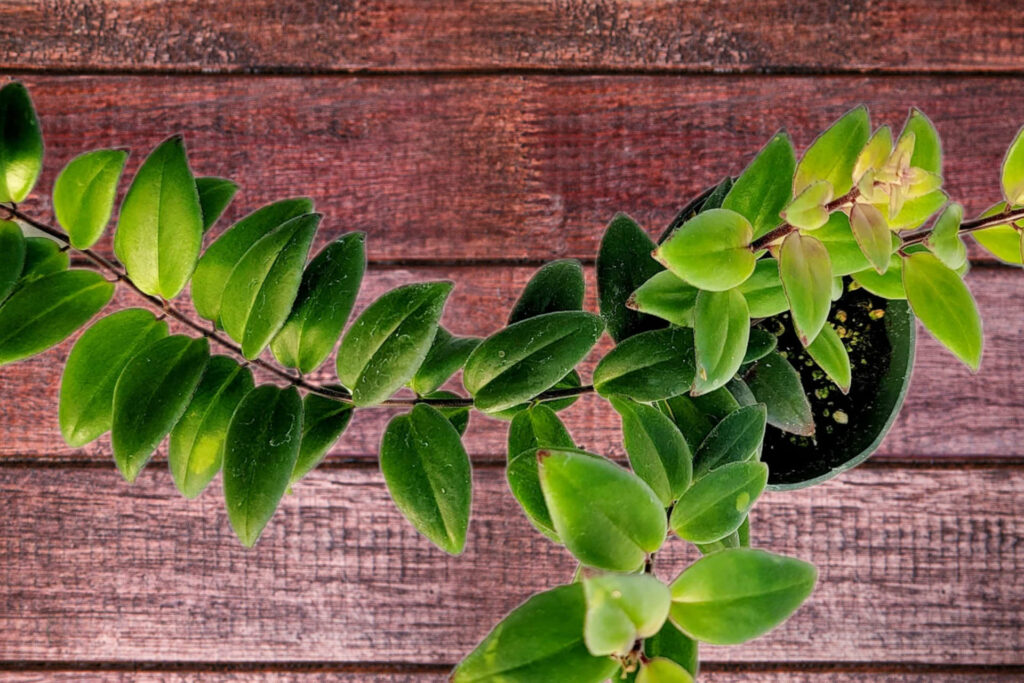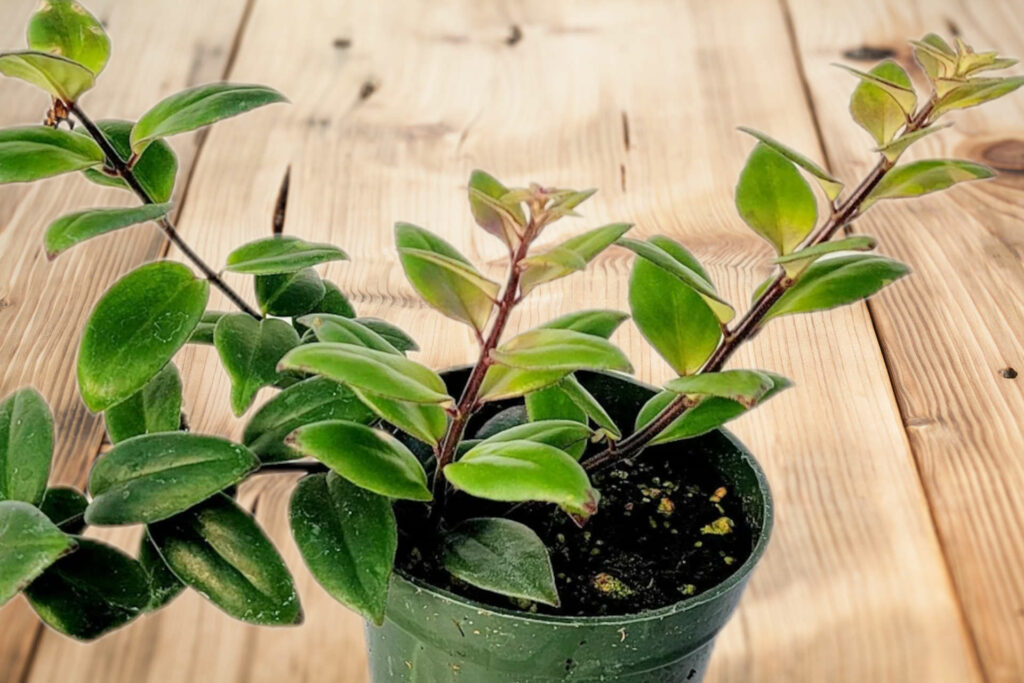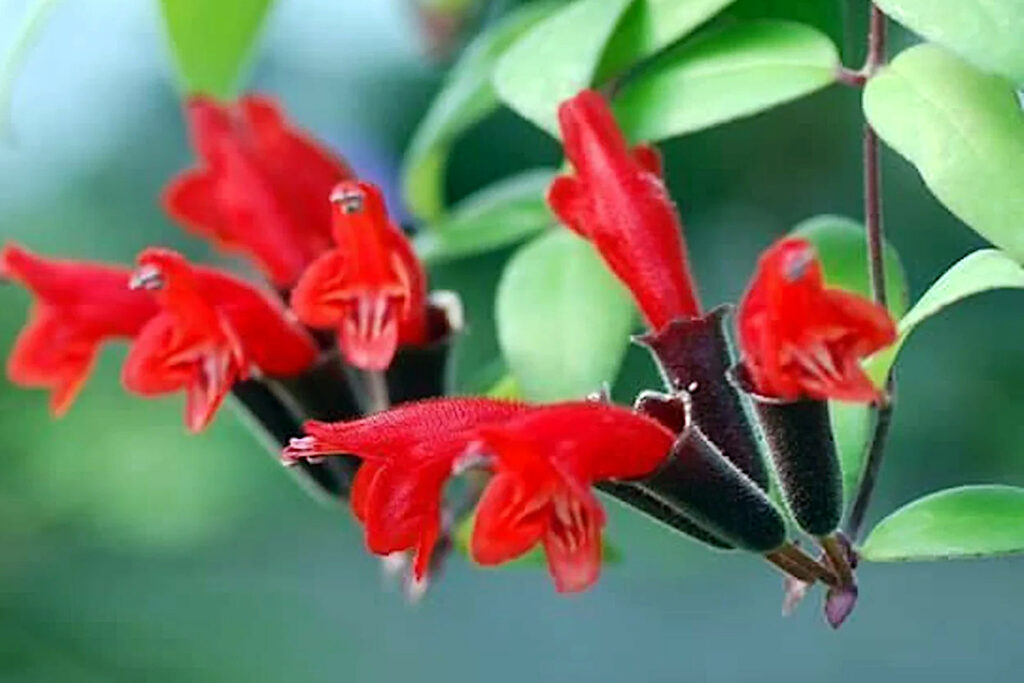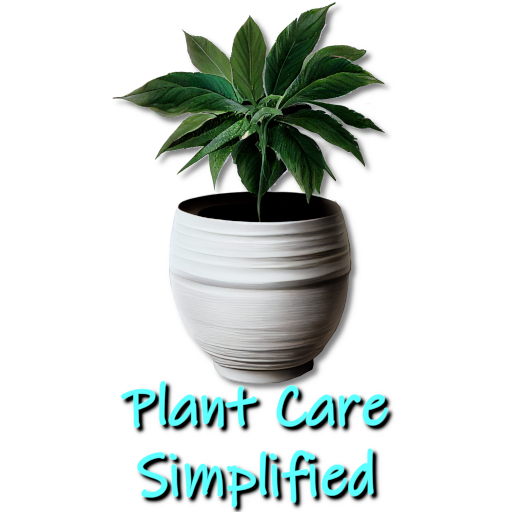Nurturing and Caring for Your Lipstick Plant (Aeschynanthus): The Key to Vibrant Blooms
Jess is a true horticulturist whose passion for plants has led her to become an expert in tropical houseplants. Jess was born and raised in...
To achieve lush foliage and vibrant blooms, properly caring for your lipstick plant (aeschynanthus), is essential, is essential. There are many valuable insights into various aspects of lipstick plant care to be found through experienced horticulturists. This guide will impart some of the most important aspects of lipstick plant care, such as soil selection, watering regimen, lighting preferences, temperature range, humidity requirements, and more.
By following these guidelines diligently, whether it's the curly leaf lipstick plant or one of the other 150 so varieties, such as the black pagoda you are caring for, you can ensure a healthy environment for your lipstick plant, irrespective of variety, while promoting its growth and flourishing beauty.
| Requirement/Property | Description |
|---|---|
| Soil/Dirt-Based Media | Aeschynanthus radicans lipstick plant prefers well-draining soil. |
| Alternative Growing Media | Peat-based or sphagnum-based soilless media also work well for lipstick plants. |
| Pot Size | The recommended pot size for a mature lipstick plant is 6-8 inches. |
| Pot Material | Terracotta, plastic, or glazed ceramic pots are suitable for growing lipstick plants. |
| Watering Requirements | Keep the soil moist but not waterlogged. Allow the top inch of soil to dry before watering. |
| Light Requirements | Lipstick plants prefer bright, indirect sunlight. Avoid direct sunlight. |
| Temperature | Aeschynanthus lipstick plant thrives in warm temperatures between 65-75°F. |
| Humidity | High humidity is preferred for lipstick plants. Mist the leaves regularly or use a humidifier. |
| Propagation | Propagate by stem cuttings in spring or summer. |
| Pruning | Prune regularly to promote bushy growth and remove dead or damaged leaves. |
| Fertilizer | Feed with a balanced liquid fertilizer every two weeks during the growing season. |
| Growth and Size | Lipstick plants can grow up to 12 inches in height and 24 inches in width. |
| Toxicity | Lipstick plants are not toxic to humans or pets. |

Aeschynanthus, belong to the Gesneriad family and is admired for their stunning tubular flowers that resemble a bright tube of lipstick. Native to Southeast Asian tropical forests, these trailing plants have gained immense popularity amongst gardening enthusiasts due to their unique appearance and relatively low-maintenance nature.
Choosing Well-Draining Soil for Aeschynanthus Plants
In their natural habitat, lipstick plants grow in moist, well-draining soil that provides a perfect balance between retaining moisture and letting the excess water seep through. When potting your aeschynanthus plant, it's crucial to recreate this environment by selecting a porous soil mix. Mixing equal parts of high-quality potting mix with perlite or orchid bark creates an ideal combination that fosters root development while preventing overwatering issues.
Exploring Different Options for Aeschynanthus Growth
While the traditional soil mix enriched with perlite or orchid bark works wonders for most lipstick plants, it's worth exploring alternative growing mediums that offer unique benefits and support your aeschynanthus plant's overall growth.
1. Coconut Coir: Going Green with a Sustainable Choice
Derived from coconut husks, coco coir (commonly called coco peat) is an eco-friendly option, perfect for retaining moisture while still providing adequate aeration to the plant's roots. Blend equal parts of coco coir and perlite to create an ideal growing mix that promotes healthy root development and offers sustainable water management.
You can also use natural peat but this is not an environmentally friendly option and is banned in some countries.
2. Sphagnum Moss: Mimicking Natural Rainforest Conditions
In tropical forests, lipstick plants frequently grow on tree branches surrounded by mosses which provide ample moisture and assist in drainage. To recreate these conditions at home, combine partially decomposed sphagnum moss with bark chips (or orchid bark) in a 1:1 ratio. This mix allows lipstick plants to thrive by enabling better air circulation around the roots while maintaining adequate dampness.
3. Semi-Hydroponics or Passive Hydroponic System: Embracing Modern Growing Techniques
Adapting innovative growing methodologies like passive hydroponics can work well for aeschynanthus plants if properly executed. Utilize expanded clay pellets (LECA) as your primary medium placed inside perforated net pots within a water reservoir system—capillary action maintains consistent moisture distribution while allowing sufficient oxygen flow around root systems.
Keep in mind each alternative medium may require specific adjustments when it comes to watering techniques, humidity levels, or fertilization preferences suited best to each method.
Picking the Perfect Pot: Size and Materials Matter
When selecting a container for your lipstick plant, consider both size and material to ensure optimal growth. A pot with a diameter between 6-8 inches is typically suitable for most aeschynanthus varieties as it allows enough space for roots to stretch out without being overly spacious.
You'll also want a planter that supports proper drainage; thus, always choose one with drainage holes at the bottom to avoid waterlogging risks. Terracotta pots are recommended due to their permeable nature, which enables excess moisture evaporation while also permitting beneficial airflow around the root system.
Remember, periodically monitoring your aeschynanthus plant's growth is essential as you may need to upgrade its container size when it outgrows its current home.
Mastering the Art of Watering for Aeschynanthus Plants
Establishing an appropriate watering regimen is crucial for maintaining the ideal moisture levels that lipstick plants need to thrive. Since aeschynanthus varieties prefer consistently damp, well-draining soil, adopt these recommended practices to hydrate your plant effectively:
- Always check the top inch or two of the soil before watering—feel free to water once it begins to dry out.
- During warmer seasons, where evaporation occurs rapidly, you may need to water your lipstick plant more frequently.
- Be cautious of overwatering—explore bottom-watering techniques if surface watering ends up being too much.
- Use room-temperature filtered or dechlorinated water as a gentle option for sustaining your aeschynanthus plant’s health.
Finding the Perfect Spot: Adequate Lighting Requirements
Aeschynanthus plants enjoy bright but indirect sunlight, which encourages their foliage and blooms' vibrancy while avoiding excessive exposure that could potentially induce sunburn or scorched leaves. This is particularly important if your lipstick plant is variegated.
Consider locating your lipstick plant in a spot where it can get consistent dappled sunlight throughout the day—east or west-facing windowsills are typically suitable choices for providing such conditions.
If natural light is not at its best in your indoor environment, opt for using full-spectrum LED grow lights instead—they simulate similar wavelengths found in natural daylight with little potential damage from excessive heat accumulation usually associated with traditional grow lights options.
Creating a Comfortable Climate: Optimal Temperature Range for Aeschynanthus Plants

Lipstick plants flourish in moderate to warm temperature ranges that mimic their native tropical habitat. A comfortable temperature spectrum between 65°F and 80°F (18°C - 27°C) is recommended to sustain healthy growth throughout the year. Keep in mind that cooler temperatures during nighttime hours, around 10-15 degrees lower, can encourage budding in certain aeschynanthus varieties.
Ensure protection from cold drafts or proximity to heat sources as sudden temperature fluctuations can be detrimental to your plant's well-being.
Maintaining a Lush Environment: High Humidity Requirements and Strategies
Aeschynanthus plants relish high humidity levels that emulate their original rainforest setting. Ideally, maintaining a relative humidity of around 60% or higher promotes healthy foliage and prevents issues such as leaf crispiness or wilting.
To boost humidity levels effectively, consider implementing these strategies:
- Grouping Plants: Position your aeschynanthus amidst other moisture-loving plants to augment ambient air dampness through natural transpiration.
- Utilizing Humidity Trays: Place your lipstick plant atop a tray filled with water-soaked pebbles—ensure the base of the pot remains above the waterline while evaporating water generates increased humidity.
- Misting Routine: Frequently sprinkle your aeschynanthus plant using filtered room-temperature water; however, avoid extreme over-misting, which might lead to fungal problems.
- Investing in a Humidifier: Placing an electronic humidifier near your lipstick plant allows precise control over desired humidity levels within its environment.
- Create a natural humidifier using clay aggregate.
Strive towards monitoring and adjusting moisture levels periodically for exceptional results when cultivating this unique tropical gem indoors.
Replicating Natural Beauty: Techniques for Propagating Aeschynanthus Plants
Creating new lipstick plant specimens through propagation offers an enjoyable and economical way to expand your aeschynanthus collection. You can grow a lipstick plant from seed or through stem cuttings, which is usually the most effective method for propagating these plants, following these simple steps:
- Carefully select a healthy, non-flowering stem tip of approximately 4-6 inches in length.
- Trim the cutting right below a leaf node, removing lower leaves while leaving the top foliage intact.
- Proceed by dipping the trimmed end into rooting hormone powder, enhancing the likelihood of successful root development.
- Plant this prepared stem cutting into a moistened soil mix within a small pot or seed tray.
- Encase your fresh propagation setup in plastic wrap or place it within a humidity dome to maintain consistently high moisture levels during this crucial growth stage.
Make sure your newly-propagated aeschynanthus enjoys an ideal environment that emulates similar temperature and lighting conditions as its parent plant.
Sustaining Vibrancy Through Regular Pruning
Prudent pruning practices contribute considerably towards retaining attractive foliage on your lipstick plant while fostering lush growth patterns. It is, though, essential to adopt proper pruning techniques. Pruning a lipstick plant stimulates a lush foliage display and promotes more prolific blossoming.
Pruning Technique
Begin by inspecting the plant for any discolored or damaged leaves, which should be carefully removed using sterilized scissors or pruners. Always make precise cuts at the base of each leaf stem, taking care not to damage adjacent stems.
Additionally, pinching back new growth tips with your fingers encourages compact development and branching for an enchanting cascading effect. For optimal aesthetics and health, prune seasonally—typically during late winter or early spring—when new growth is about to commence after its dormancy period.
General Pruning Advice
Don't hesitate to remove withering leaves or flower remnants as part of regular maintenance—they may detract from reaching full aesthetic potential, aside from potentially harboring pests when neglected over time.
Trimming back the leggy stems just above leaf nodes helps attain compact structures and ensures consistent flowering cycles in more mature plants—try to implement moderate pruning after each blossoming period to maintain desired form, enhance air circulation and encourage bud formation on newer growth tips.
Feeding Your Aeschynanthus Plant: Appropriate Fertilizer Choices

Supplying your lipstick plant with the proper nutrients is vital for sustaining its energetic growth and vibrant blooms. Generally, a balanced, water-soluble fertilizer such as 20-20-20 or one specifically formulated for flowering houseplants works well for meeting Aeschynanthus requirements.
During its active growing period (spring through late summer), consider fertilizing your lipstick plant approximately once a month, diluting the solution to half-strength to prevent over-fertilization or salt build-up in the soil.
Refrain from feeding during cooler months while reducing the watering frequency when growth typically slows down.
Predicting Potential Growth & Size of Aeschynanthus Plants
Understanding what to expect concerning your aeschynanthus plant's development empowers you to plan care routines more diligently—anticipate most lipstick plant varieties exhibiting vigorous trailing tendencies with flexible stems, easily reaching lengths between 2-4 ft (60-120 cm) when allowed ample room to grow uninterrupted.
Properly nurtured plants may display dazzling blooms throughout spring and summer months or sometimes even longer. Blossoms usually emerge in clusters near foliage tips dangling daintily above green trailing leaves—note that various aeschynanthus species showcase uniquely colorful flowers ranging from orange hues through burgundies and glowing red tones.
Peace of Mind with Aeschynanthus Plants: Non-Toxic Nature
One of the highlights of growing lipstick plants, irrespective of variety, in your home or garden is their non-toxic nature, which renders them safe around children, cats, and dogs.
Despite not posing a direct threat to your loved ones or furry friends, it's still wise to discourage ingestion as any plant material can potentially cause mild digestive upset if consumed in large quantities.
In the unlikely event that you do notice any adverse reaction or have any concerns after your cat, dog, or child has come into contact with a lipstick plant, then it is advisable to consult a veterinarian or medical professional.
Guarding Greenery: Tips for Safe Handling and Care
While aeschynanthus plants are relatively low-maintenance additions to your indoor garden, adopting safety measures during care responsibilities will make plant interactions even more enjoyable:
- Wear gloves while pruning or handling soil amendments—this protects you from potential skin irritation while safeguarding the delicate stems from unnecessary damage.
- Ensure stability when positioning lipstick plants on elevated surfaces—trailing stems may cascade downwards towards areas frequented by curious pets or young children; stay vigilant regarding stem placement.
- Implement gentle lipstick plant pest management strategies—if facing aphids or other pest invasions, employ organic insecticidal soaps or neem oil treatments that prove milder on both the plant itself along with its human caretakers compared to various chemical alternatives.
Bolstering Beauty through Proper Care: Aeschynanthus Plants' Health & Longevity
In summary, the key to enjoying your lipstick plant's lush foliage and stunning blossoms is understanding and catering to its unique preferences—combining well-draining soil with suitable pot selection, consistently damp yet breathable growing conditions, optimal lighting exposure, favorable temperature ranges, and humidity levels all contribute significantly to a thriving aeschynanthus plant.
Moreover, diligent pruning schedules serve both aesthetic and practical purposes while implementing propagation techniques paves the way for multiplying your collection of mesmerizing lipstick plants.
By adhering faithfully to these outlined guidelines for care, you can ensure your aeschynanthus plant's health and longevity—as a result reaping endless rewards in the form of captivating floral displays along with enchanting greenery that brightens any indoor living space.
Further Reading
- NC State University and N.C. A&T State University: Aeschynanthus radicans
- Biodiversitas Journal of Biological Diversity: Flower development, pollen viability and pollen storage test of Aeschynanthus radicans
Useful Videos
Jess is a true horticulturist whose passion for plants has led her to become an expert in tropical houseplants. Jess was born and raised in South East Asia surrounded by lush jungles and lush botanical gardens. This environment prompted her to develop a love for all things green and growing. A move to the UK helped her plant care skills and improved her knowledge Her commitment to her craft and her dedication to her customers has earned her a reputation as one of the best in the business. She continues to inspire others with her love for nature and the environment.Bio Page
More Posts